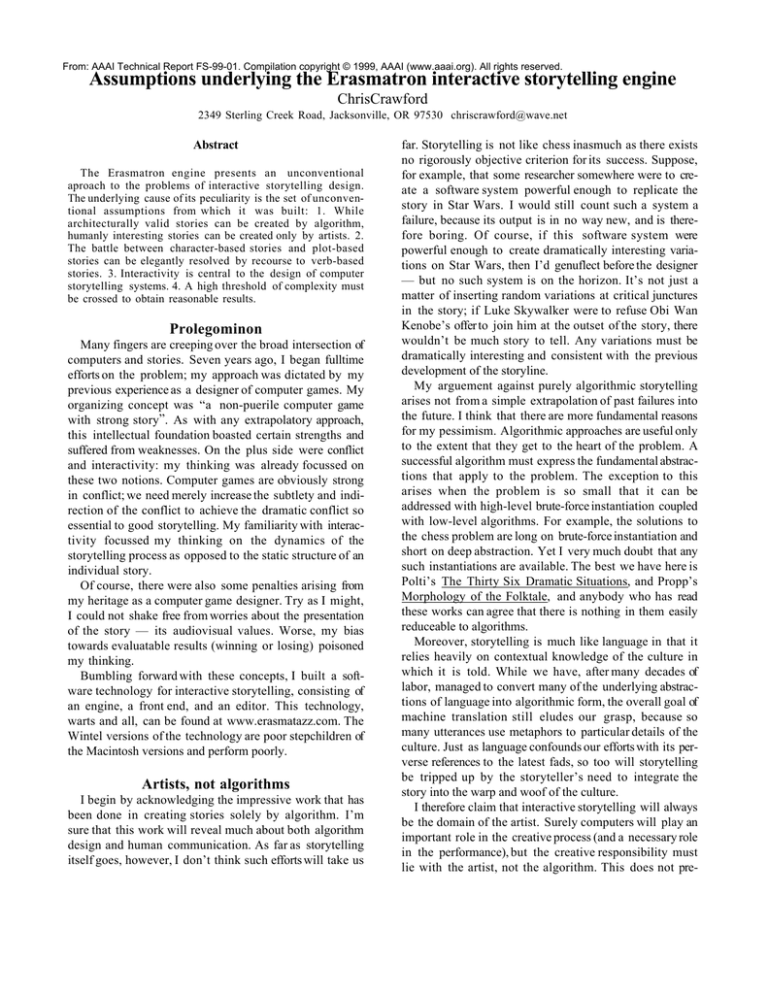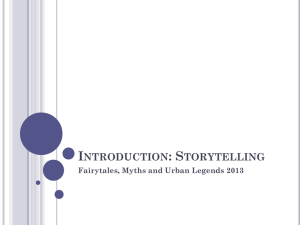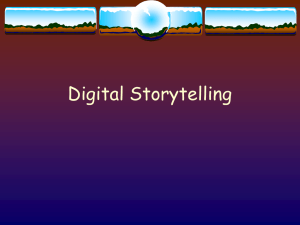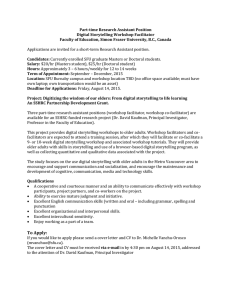
From: AAAI Technical Report FS-99-01. Compilation copyright © 1999, AAAI (www.aaai.org). All rights reserved.
Assumptions underlying the Erasmatron interactive storytelling engine
ChrisCrawford
2349 Sterling Creek Road, Jacksonville, OR 97530 chriscrawford@wave.net
Abstract
The Erasmatron engine presents an unconventional
aproach to the problems of interactive storytelling design.
The underlying cause of its peculiarity is the set of unconventional assumptions from which it was built: 1. While
architecturally valid stories can be created by algorithm,
humanly interesting stories can be created only by artists. 2.
The battle between character-based stories and plot-based
stories can be elegantly resolved by recourse to verb-based
stories. 3. Interactivity is central to the design of computer
storytelling systems. 4. A high threshold of complexity must
be crossed to obtain reasonable results.
Prolegominon
Many fingers are creeping over the broad intersection of
computers and stories. Seven years ago, I began fulltime
efforts on the problem; my approach was dictated by my
previous experience as a designer of computer games. My
organizing concept was “a non-puerile computer game
with strong story”. As with any extrapolatory approach,
this intellectual foundation boasted certain strengths and
suffered from weaknesses. On the plus side were conflict
and interactivity: my thinking was already focussed on
these two notions. Computer games are obviously strong
in conflict; we need merely increase the subtlety and indirection of the conflict to achieve the dramatic conflict so
essential to good storytelling. My familiarity with interactivity focussed my thinking on the dynamics of the
storytelling process as opposed to the static structure of an
individual story.
Of course, there were also some penalties arising from
my heritage as a computer game designer. Try as I might,
I could not shake free from worries about the presentation
of the story — its audiovisual values. Worse, my bias
towards evaluatable results (winning or losing) poisoned
my thinking.
Bumbling forward with these concepts, I built a software technology for interactive storytelling, consisting of
an engine, a front end, and an editor. This technology,
warts and all, can be found at www.erasmatazz.com. The
Wintel versions of the technology are poor stepchildren of
the Macintosh versions and perform poorly.
Artists, not algorithms
I begin by acknowledging the impressive work that has
been done in creating stories solely by algorithm. I’m
sure that this work will reveal much about both algorithm
design and human communication. As far as storytelling
itself goes, however, I don’t think such efforts will take us
far. Storytelling is not like chess inasmuch as there exists
no rigorously objective criterion for its success. Suppose,
for example, that some researcher somewhere were to create a software system powerful enough to replicate the
story in Star Wars. I would still count such a system a
failure, because its output is in no way new, and is therefore boring. Of course, if this software system were
powerful enough to create dramatically interesting variations on Star Wars, then I’d genuflect before the designer
— but no such system is on the horizon. It’s not just a
matter of inserting random variations at critical junctures
in the story; if Luke Skywalker were to refuse Obi Wan
Kenobe’s offer to join him at the outset of the story, there
wouldn’t be much story to tell. Any variations must be
dramatically interesting and consistent with the previous
development of the storyline.
My arguement against purely algorithmic storytelling
arises not from a simple extrapolation of past failures into
the future. I think that there are more fundamental reasons
for my pessimism. Algorithmic approaches are useful only
to the extent that they get to the heart of the problem. A
successful algorithm must express the fundamental abstractions that apply to the problem. The exception to this
arises when the problem is so small that it can be
addressed with high-level brute-force instantiation coupled
with low-level algorithms. For example, the solutions to
the chess problem are long on brute-force instantiation and
short on deep abstraction. Yet I very much doubt that any
such instantiations are available. The best we have here is
Polti’s The Thirty Six Dramatic Situations, and Propp’s
Morphology of the Folktale, and anybody who has read
these works can agree that there is nothing in them easily
reduceable to algorithms.
Moreover, storytelling is much like language in that it
relies heavily on contextual knowledge of the culture in
which it is told. While we have, after many decades of
labor, managed to convert many of the underlying abstractions of language into algorithmic form, the overall goal of
machine translation still eludes our grasp, because so
many utterances use metaphors to particular details of the
culture. Just as language confounds our efforts with its perverse references to the latest fads, so too will storytelling
be tripped up by the storyteller’s need to integrate the
story into the warp and woof of the culture.
I therefore claim that interactive storytelling will always
be the domain of the artist. Surely computers will play an
important role in the creative process (and a necessary role
in the performance), but the creative responsibility must
lie with the artist, not the algorithm. This does not pre-
clude the possibility of the artist creating the algorithms;
indeed, the Erasmatron requires the artist to supply a great
many simple algorithms for character choices. But these
are narrowly-applied algorithms; overall creative strategy
remains a task for neurons, not transistors.
This claim has big implications for the way we should
proceed. Our task shifts from designing the storytelling
iself to designing the infrastructures in which the artists
will work, and the tools they will need to do so. It’s
rather like the use of word processors. The designer of the
word processor makes no attempt to design the content of
the documents to be created with the word processor;
instead, the designer defines the mental image that organizes the user’s thinking while writing the document. For
example, the introduction of multiple fonts and typestyles
has changed the way the average user creates documents.
People now freely use boldface, underlining, italics, and
multiple fonts to endow their words with additional meaning. We must do the same thing on a much larger and
more abstract scale — but we must refrain from intruding
into the artistic side of storytelling. This decision
demands more than intelligence: it requires wisdom.
I am too conceited to permit the requirement of wisdom
to deter me from attempting a solution. With the
Erasmatron, I segregated artistic functions from algorithmic functions based on my assessment of the artistic
content of each function. Character movement, for example, is directly controlled by algorithm and indirectly
controlled by the artist. To wit, if the artist sets a dramatic goal for the character, such as “beat up Joe”, the
algorithms will move the character to the stage occupied
by Joe. If the character has no assignments, then the algorithms will move the character randomly, based on
artist-assigned values of “Wanderlust” for each character
and “Territorialities” for each stage and character.
Similarly, I decided that gossip-functions are too mundane to be directly controlled by the artist. Therefore, the
artist declares the “Loquacity” of each character, who then
gossips with other characters based on that loquacity and
algorithmic decisions as to the import of the gossip to the
recipient, the desirability of the recipient’s likely reaction,
the intrinsic credibility of the gossip, and the possibly
secretive nature of the information in question.
The dramatically most critical decisions are the verb
choices made by the characters: how they react to the
events they experience. These decisions are all under the
direct control of the artist. I have learned, however, that
few artists are willing to endure the mathematical tedium
required by this control, and am currently modifying the
Erasmatron to reduce the tedium without compromising
artistic control. More details on these modifications can be
found at www.erasmatazz.com/Version 2.0/index.html.
Plot-based stories vs character-based stories
This is an old battle amongst writers. Some argue that
“character drives story” while others insist that “plot IS
story”. Each side acknowledges the importance and necessity of the other’s favored element; the dispute revolves
around which should be accorded primacy. This problem
has fascinating correlates in many other fields such as
physics (waves vs particles), economics (services vs
goods), computer science (cycles vs bytes), and linguistics
(verb versus noun). For more on this topic, see www.erasmatazz.com/library/miscellania/OperationalDefinition.html
My own opinion is that the plot-based approach is truly
more fundamental, but the character-based approach is
often more useful. Writers can use character-based
approaches to address storytelling problems that simply
cannot be resolved using plot-based approaches.
However, we need not waste energy debating this problem, for we can neatly sidestep it in the limited domain of
interactive storytelling by thinking in terms of verbs and
sentences. Thus, our fundamental design atom is not
{character possessed of certain attributes, motivations,
hang-ups, etc}; nor is it {plot composed of certain critical
points, twists, and junctions}; it is instead {sentence consisting of subject, verb, direct object, and other elements}.
This schema allows us to analyze the problem along
cleavage lines that are easier to work with. The two warring concepts of character and plot are merged at an atomic
level in the sentence. Our task then becomes to define the
verbs available during storytelling and the character-istics
that will lead to one verb-choice rather than another.
This sentence-based approach is the core of the
Erasmatron technology. The central element of each sentence is the verb; the editor is therefore organized around
the master list of verbs for a storyworld. The artist
declares, for each verb, a set of roles defined by the relationships with the actors in the sentence. For example, the
verb “beat up” would likely be accompanied by roles for
the victim, a disinterested bystander, a sympathetic
bystander, and so on. Each role includes a set of options
(verbs) that constitute dramatically reasonable reactions to
the predicating event. The meaning of verbs is extensible
by means of the inclusion of “secondary objects”. These
take the place of indirect objects, prepositional objects,
adverbial phrases, or the components of dependent clauses;
their meaning is intrinsic to the definition of the verb.
This crude mechanism vastly extends the expressive
power of verbs without requiring complex linguistic parsing.
Interactivity
This is more a matter of defining ends rather than
means. If we were able to get computers to think success-
fully about storytelling, what would we use this newfound talent for? While agent technology has obvious and
important applications in improving user interface and creating proactive software resources, the computer as
storyteller seems rather lost without the element of interactivity. After all, what entertainment, explanatory, or
educational value would a computer storyteller have in the
absence of interactivity? Interactivity lies at the heart of
the computer revolution; we must set our compass by its
poles. We must factor interactivity into our design effort at
a fundamental level. Thus, our task is not to create computer stories and then tack some kind of interactivity onto
them; our task is to design interactive computer storytelling from the ground up. The operational expression of
this goal is the question “What does the user do?” Note
that this key question is almost impossible to answer
when one thinks in terms of characters or plots. The
character-based designer faces utter nullity, for the character
of the user is necessarily unknown. The plot-based
designer finds the free will of the user diametrically
opposed to the imposition of plot. The apparent conflict
between interactivity and narrative has confounded people
for too long; detailed explanations of the chimerical nature
of this conundrum can be found at www.erasmatazz.com/
library/ lilan/inimical.html.
Complexity Threshold
The challenge of interactive storytelling is made more
difficult by the high threshold of complexity required by
the audience. A great many successes in computer science
involve, in some way, “faking it”: providing a solution
not quite the same as that desired by the user, but hardly
distinguishable from the desideratum. Storytelling, however, crawls with complexity expectations on the part of
the users. Stories must reflect the complexities of our personalities and cultures; if they don’t, audiences disdain
them. Such high expectations render useless the traditional analysis and synthesis approach that serves so well
elsewhere. A story that runs afoul of some well-known
detail of human behavior will be dismissed out of hand.
I first learned this lesson some years ago while building
my first interactive storyworld, Le Morte D’Arthur. My
interactive version of the Arthurian tale did not fail to
include the requisite affair between Lancelot and
Gwenevere. Unfortunately, my algorithm for gossip was
mostly but not completely successful in representing
human behavior. Thus, after Lancelot bedded Gwenevere,
he was so excited that he felt a need to share this great
news with a close friend, a friend whom he could trust —
who turned out to be Arthur!
All of us can smile at so egregious a blunder, yet consider this: if we were to compile a list of human behaviors
required to successfully model characters in our story-
telling, the rule “Don’t tell your best friend about your
sexual exploits if he’s married to your partner” would
surely fall far down on the list.
Any storytelling software must be equipped with algorithms of great complexity before it can yield interesting
results. Building from the ground up, one feature at a
time, will yield results so far short of genuine storytelling
as to obviate any useful feedback on the design. We can’t
build living systems by stitching together body parts and
zapping them with high voltage a la Frankenstein. Nor
can we succeed by playing chemistry games with amino
acids. The minimum threshold of complexity is the gene
of DNA — a very large and complicated structure. Many
of the early attempts at interactive storytelling have a
Frankensteinian air about their designs.
I believe that the Erasmatron bristles with enough
behavioral complexity to inch its way over the threshold
of storytelling complexity. Aside from the obvious reaction, plan-making and plan-execution facilities, it offers a
capability for anticipating likely reactions to a contemplated move; the ability to tell lies and reveal secrets, and
later to track them down to their source; defer intended
behaviors if they might be witnessed by the wrong people,
and so forth. Indeed, I have been hoisted by my own
petard in the matter of complexity: as yet, largely because
of its complexity, not a single artist has completed creation of a viable storyworld using the Erasmatron!
I am therefore re-writing the Erasmatron with the primary purpose of easing the artist’s workload. This
involves some simplification of the engine, but most of
the changes are means of assisting the artist in handling
the complexity.
Assisted Storytelling
Recognition of the complexity threshold does not
necessitate abandonment of our goal. Pursuit of a lesser
goal now might put us in a position to tackle the ultimate
objective later. The Erasmatron demonstrates that interactive storytelling can be achieved, but only with the
application of Herculean efforts. This suggests that a
junior form of interactive storytelling might be better
suited to the current inexperience of the artistic community. One such junior form I will call “assisted
storytelling”. It uses the Erasmatron technology in every
way but one: the user, not the artist’s algorithms, makes
the choices for the characters. This transforms the user
from protagonist to director. The artist’s role is altered
concomitantly: s/he now determines dramatically viable
options and defines the roles for them, but no longer provides the inclination equations that govern character
choices. This greatly reduces overall effort, making the
technology more accessible to the artist community.







